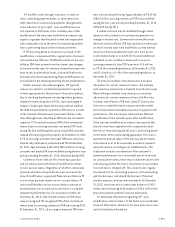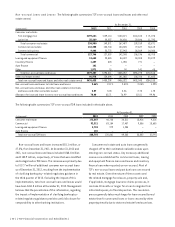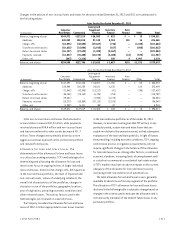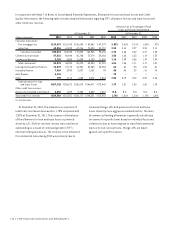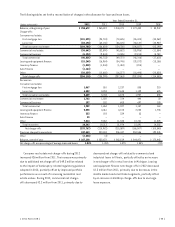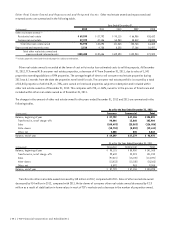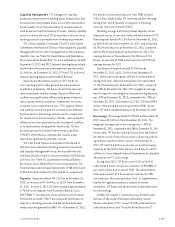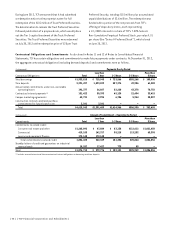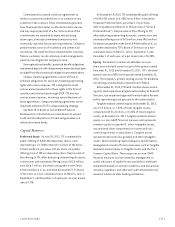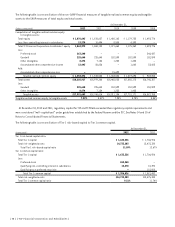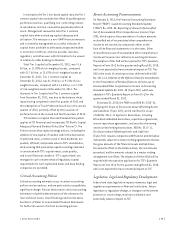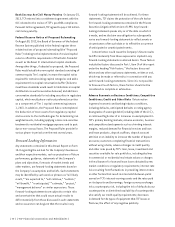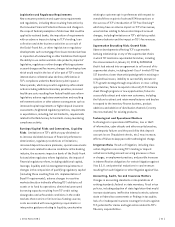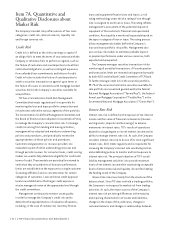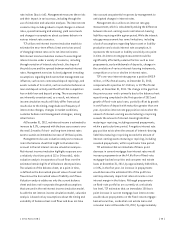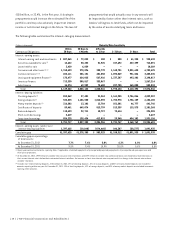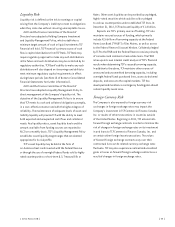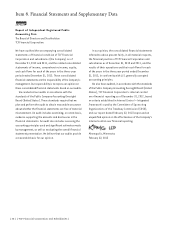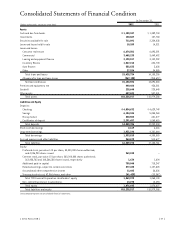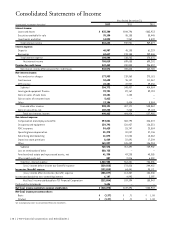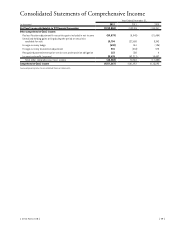TCF Bank 2012 Annual Report Download - page 65
Download and view the complete annual report
Please find page 65 of the 2012 TCF Bank annual report below. You can navigate through the pages in the report by either clicking on the pages listed below, or by using the keyword search tool below to find specific information within the annual report.In contrast to the Tier 1 risk-based capital ratio, the Tier 1
common capital ratio excludes the effect of qualifying trust
preferred securities, qualifying non-controlling interest
in subsidiaries and non-cumulative perpetual preferred
stock. Management reviews the total Tier 1 common
capital ratio when evaluating capital adequacy and
utilization. This measure is a non-GAAP financial measure
and is viewed by management as a useful indicator of
capital levels available to withstand unexpected market
or economic conditions, and also provides investors,
regulators, and other users with information to be viewed
in relation to other banking institutions.
Total Tier 1 capital at December 31, 2012, was $1.6
billion, or 11.09% of risk-weighted assets, compared
with $1.7 billion, or 12.67% of risk-weighted assets at
December 31, 2011. Tier 1 common capital at
December 31, 2012, was $1.4 billion, or 9.21% of risk-
weighted assets, compared with $1.6 billion, or 11.74%
of risk-weighted assets at December 31, 2011. The
decrease in Tier 1 capital and Tier 1 common capital
from December 31, 2011, was due to the balance sheet
repositioning completed in the first quarter of 2012 and
the redemption of Trust Preferred Securities in the second
quarter of 2012, partially offset by the issuances of
preferred stock in the second and fourth quarters of 2012.
TCF maintains a Capital Plan and Dividend Policy which
applies to TCF Financial and incorporates TCF Bank’s Capital
Adequacy Plan and Dividend Policy (the “Policies”). The
Policies ensure that capital strategy actions, including the
addition of new capital, if needed, and/or the declaration
of preferred stock, common stock or bank dividends, are
prudent, efficient, and provide value to TCF’s stockholders,
while ensuring that past and prospective earnings retention
is consistent with TCF’s capital needs, asset quality,
and overall financial condition. TCF’s capital levels are
managed in such a manner that all regulatory capital
requirements for well-capitalized banks and bank holding
companies are exceeded.
Critical Accounting Policies
Critical accounting estimates occur in certain accounting
policies and procedures, and are particularly susceptible to
significant change. Policies that contain critical accounting
estimates include the determination of the allowance for
loan and lease losses, lease financings and income taxes.
See Note 1 of Notes to Consolidated Financial Statements
for further discussion of critical accounting policies.
Recent Accounting Pronouncements
On February 5, 2013, the Financial Accounting Standards
Board (“FASB”) issued Accounting Standards Update
(“ASU”) No. 2013-02, Reporting of Amounts Reclassified
Out of Accumulated Other Comprehensive Income (Topic
220), which requires the presentation of certain amounts
reclassified out of accumulated other comprehensive
income to net income, by component, either on the
face of the financial statements or in the notes. Other
reclassifications out of accumulated other comprehensive
income will require cross reference to existing disclosures.
The adoption of this ASU will be required for TCF’s Quarterly
Report on Form 10-Q for the quarter ending March 31, 2013,
and is not expected to have a material impact on TCF. This
ASU is the result of certain provisions deferred within ASU
No. 2011-12, Deferral of the Effective Date for Amendments
to the Presentation of Reclassifications of Items out of
Accumulated Other Comprehensive Income in Accounting
Standards Update No. 2011-05 (Topic 220), which was
adopted in TCF’s Quarterly Report on Form 10-Q for the
quarter ended March 31, 2012.
On January 31, 2013, the FASB issued ASU No. 2013-01,
Clarifying the Scope of Disclosures about Offsetting Assets
and Liabilities (Topic 210), which clarifies the scope
of ASU No. 2011-11 applies to derivatives, including
bifurcated embedded derivatives, repurchase agreements,
reverse repurchase agreements, and securities borrowing
and securities lending transactions. ASU No. 2011-11,
Disclosures about Offsetting Assets and Liabilities
(Topic 210), requires companies with financial and derivative
instruments subject to a master netting agreement to disclose
the gross amounts of the financial assets and liabilities,
the amounts offset on the balance sheet, the net amounts
presented, and the amounts subject to a master netting
arrangement not offset. The adoption of these ASUs will be
required with retrospective application for TCF’s Quarterly
Report on Form 10-Q for the quarter ending March 31, 2013,
and is not expected to have a material impact on TCF.
Legislative, Legal and Regulatory Developments
Federal and state legislation imposes numerous legal and
regulatory requirements on financial institutions. Future
legislative or regulatory change, or changes in enforcement
practices or court rulings, may have a dramatic and
potentially adverse impact on TCF.
{ 2012 Form 10K } { 49 }


